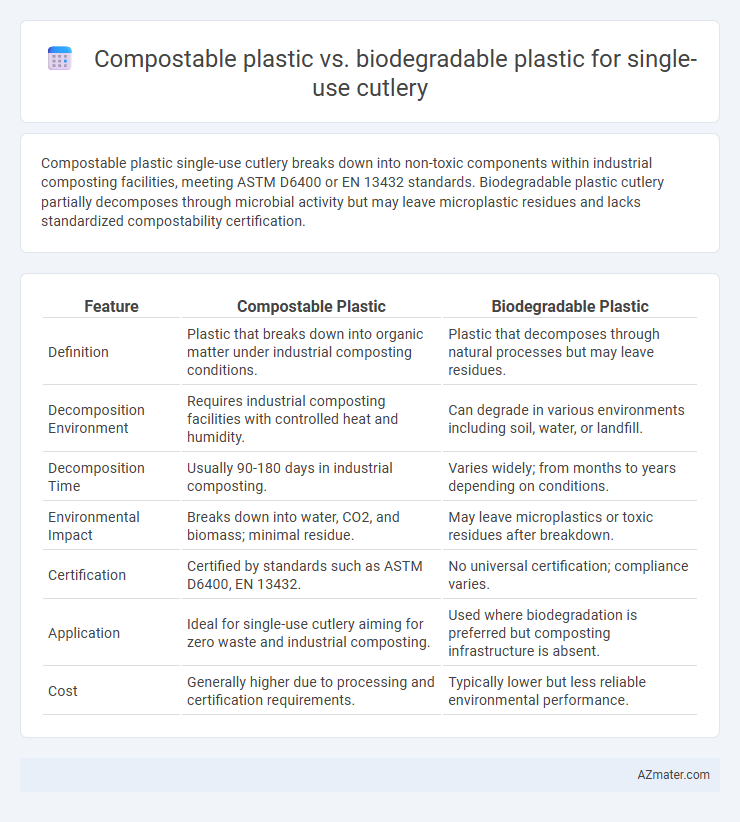Compostable plastic single-use cutlery breaks down into non-toxic components within industrial composting facilities, meeting ASTM D6400 or EN 13432 standards. Biodegradable plastic cutlery partially decomposes through microbial activity but may leave microplastic residues and lacks standardized compostability certification.
Table of Comparison
| Feature | Compostable Plastic | Biodegradable Plastic |
|---|---|---|
| Definition | Plastic that breaks down into organic matter under industrial composting conditions. | Plastic that decomposes through natural processes but may leave residues. |
| Decomposition Environment | Requires industrial composting facilities with controlled heat and humidity. | Can degrade in various environments including soil, water, or landfill. |
| Decomposition Time | Usually 90-180 days in industrial composting. | Varies widely; from months to years depending on conditions. |
| Environmental Impact | Breaks down into water, CO2, and biomass; minimal residue. | May leave microplastics or toxic residues after breakdown. |
| Certification | Certified by standards such as ASTM D6400, EN 13432. | No universal certification; compliance varies. |
| Application | Ideal for single-use cutlery aiming for zero waste and industrial composting. | Used where biodegradation is preferred but composting infrastructure is absent. |
| Cost | Generally higher due to processing and certification requirements. | Typically lower but less reliable environmental performance. |
Understanding Compostable vs Biodegradable Plastics
Compostable plastics for single-use cutlery break down into non-toxic components within industrial composting systems, meeting specific standards such as ASTM D6400 or EN 13432. Biodegradable plastics degrade over time through microbial activity but may leave behind microplastics or residues without necessarily breaking down fully in composting environments. Choosing compostable plastics ensures complete decomposition aligned with waste management infrastructure, whereas biodegradable plastics offer variable degradation based on environmental conditions.
Material Composition of Single-Use Cutlery
Single-use cutlery made from compostable plastic typically consists of plant-based polymers such as polylactic acid (PLA) or starch blends, designed to break down into organic matter under industrial composting conditions. In contrast, biodegradable plastic often contains petroleum-derived polymers with additives that enable microbial degradation, but this process may produce microplastics and requires specific environmental factors for complete breakdown. Understanding the material composition highlights the environmental impact and disposal requirements unique to each type of single-use cutlery.
Degradation Processes: Compostable vs Biodegradable
Compostable plastic for single-use cutlery breaks down through microbial activity in industrial composting facilities, converting into water, carbon dioxide, and biomass within 90 days under controlled temperature and humidity. Biodegradable plastic degrades more variably, relying on natural environmental conditions such as soil or marine ecosystems, often taking longer and producing residual microplastics. The predictable, residue-free degradation of compostable plastics supports sustainable waste management by enabling closed-loop composting systems designed for organic waste streams.
Certification Standards and Labeling
Compostable plastic single-use cutlery must meet certification standards such as ASTM D6400 or EN 13432, ensuring complete breakdown in industrial composting facilities within specific timeframes. Biodegradable plastics may degrade under varying conditions but lack uniform certification, often leading to unclear labeling and consumer confusion. Accurate labeling based on recognized certifications helps consumers distinguish truly compostable cutlery from those that only partially degrade or require special disposal methods.
Environmental Impact Comparison
Compostable plastic single-use cutlery breaks down into organic matter under industrial composting conditions, reducing landfill waste and lowering greenhouse gas emissions compared to traditional plastics. Biodegradable plastics decompose through microbial activity but may fragment into microplastics if not properly managed, posing potential environmental hazards. Compostable cutlery offers a more sustainable end-of-life option when accurately sorted and processed, minimizing soil and water contamination risks.
End-of-Life Scenarios for Cutlery
Compostable plastic single-use cutlery breaks down into organic matter under industrial composting conditions within 90 to 180 days, leaving no toxic residue, which supports circular waste management systems. Biodegradable plastic cutlery degrades through microbial activity in natural or landfill conditions but often requires longer timeframes and may leave microplastic residues, complicating pollution control. End-of-life scenarios for compostable cutlery include industrial composting facilities, while biodegradable cutlery's degradation largely depends on specific environmental factors, impacting landfill and marine waste management strategies.
Consumer Misconceptions and Confusion
Consumers often confuse compostable plastic with biodegradable plastic in single-use cutlery, mistakenly believing both break down equally fast in natural environments. Compostable plastics require industrial composting facilities with specific conditions, while biodegradable plastics may degrade irregularly and release microplastics. This misunderstanding leads to improper disposal, reducing environmental benefits and increasing plastic pollution risks.
Disposal Infrastructure and Practicality
Compostable plastic single-use cutlery requires industrial composting facilities with controlled temperature and humidity to break down effectively, limiting its practical disposal in areas lacking such infrastructure. Biodegradable plastic cutlery can degrade in various environments, including home composting and landfill conditions, but decomposition rates vary widely and may leave microplastic residues. Effective disposal depends heavily on local waste management capabilities, influencing the environmental benefits and convenience of using either material.
Regulatory Policies and Bans
Regulatory policies increasingly favor compostable plastics for single-use cutlery due to their capability to break down in industrial composting facilities within specific time frames, aligning with waste management standards set by entities like the EU's Single-Use Plastics Directive. Biodegradable plastics often face stricter scrutiny and bans because they may degrade unpredictably in natural environments, posing risks of microplastic pollution. Governments worldwide, including in California and the UK, implement bans or restrictions targeting traditional and ambiguous biodegradable cutlery, promoting certified compostable alternatives that comply with ASTM D6400 or EN 13432 standards.
Choosing the Right Option for Sustainability
Compostable plastics for single-use cutlery break down into non-toxic components under industrial composting conditions, offering a closed-loop solution that reduces landfill waste and supports soil health. Biodegradable plastics degrade through microbial action but may leave microplastic residues, posing environmental risks if not properly managed. Selecting compostable cutlery ensures higher sustainability by aligning with waste treatment infrastructures and minimizing long-term ecological impact.

Infographic: Compostable plastic vs Biodegradable plastic for Single-use cutlery
 azmater.com
azmater.com